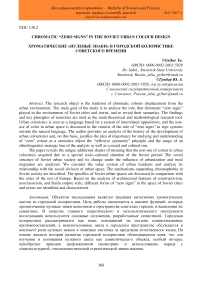Chromatic “zero signs” in the Soviet urban colour design
Автор: Griber Yuliya
Журнал: Бюллетень науки и практики @bulletennauki
Рубрика: Искусство и культура
Статья в выпуске: 12 (25), 2017 года.
Бесплатный доступ
The research object is the tradition of сhromatic colours displacement from the urban environment. The main goal of the study is to analyse the role, that chromatic “zero signs” played in the environment of Soviet cities and towns, and to reveal their semantics. The findings and key principles of semiotics are used as the main theoretical and methodological research tool. Urban coloristics is seen as a language based on a system of interrelated oppositions, and the non-use of color in urban space is discussed in the context of the role of “zero signs” in sign systems outside the natural language. The author provides an analysis of the history of the development of urban colouristics and, on this basis, justifies the idea of importance for studying and understanding of “zero” colour as a semiotics object the “reflexive symmetry” principle and the usage of an ethnolinguistic strategic line of the analysis as well as a social and cultural one. The paper reveals the unique additional shades of meaning that the non-use of colour in urban coloristics acquired due to a special socio-cultural situation of the Soviet period. The social structure of Soviet urban society and its change under the influence of urbanization and rural migration are analyzed. We consider the value system of urban residents and analyze its relationship with the social division of urban space. The mechanisms supporting chromophobia in Soviet society are described. The specifics of Soviet urban spaces are discussed in comparison with the cities of the rest of Europe. Based on the analysis of architectural features of constructivism, neoclassicism, and Stalin empire style, different forms of “zero signs” in the space of Soviet cities and towns are identified and characterized.
Colour, city, urban coloristis, colour design, sign, "zero" sign, soviet period
Короткий адрес: https://sciup.org/14111403
IDR: 14111403 | УДК: 130.2 | DOI: 10.5281/zenodo.1116415
Список литературы Chromatic “zero signs” in the Soviet urban colour design
- Batchelor D. Chromophobia. London: Reaktion books, 2007. 128 p.
- Minah G. Blackness. Whitness. Chromaticness. Formulas for High Visibility in the Modern City//Color Communication and Management. AIC Proceeding/ed. by A. Hansuebsai. Bangkok, 2003. Р. 26-30.
- Серов Н. В. Цвет культуры: психология, культурология, физиология. СПб.: Речь, 2004. 672 с.
- Грибер Ю. А. Цветовые репрезентации социального пространства европейского города. М.: Согласие, 2013. 480 с.
- Wagner-Rieger R. Wiens Architektur im 19. Jahrhundert. Wien: Oesterreichischer Bundesverlag, 1970. 308 S.
- Розов М. А. История науки и проблема ее рациональной реконструкции//Исторические типы рациональности/отв. ред. В.А. Лекторский. Т. 1. М.: Изд-во ИФ РАН, 1995. С. 157-192.
- Пивоваров Ю. Л. Урбанизация в России в ХХ веке: представления и реальность//Общественные науки и современность. 2001. №6. С. 101-113.
- Arrarte-Grau M., Ludmir B. Lima Actual: El Color de la Vivienda. Lima: Universidad Ricardo Palma, 1987.
- Грибер Ю. А. История цветового проектирования городского пространства: сборник документов и материалов. Смоленск: Изд-во СмолГУ, 2015. 350 с.
- Паперный В. Мужчины, женщины и жилое пространство//Жилище в России: век ХХ. Архитектура и социальная история: монографический сборник/сост. У. Брумфилд, Б. Рубл. М.: Три квадрата, 2001. С. 90-103.
- Барт Р. Camera lucida: комментарий к фотографии/пер., послесл. и коммент. М. Рыклина. М.: Ad Marginem, 1997. 223 с.
- Фасмер М. Этимологический словарь русского языка. М.: ИДДКБ, 2004. (CD-ROM).
- Ozenfant A. Color Solidity//Architectural Review. 1937. №81. P. 243-246.


